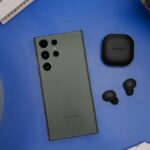
Samsung has pulled the wraps off its Exynos 2200 chip for smartphones. It is the first SoC to feature AMD’s RDNA 2 graphics architecture, enabling desktop-grade graphics features such as hardware-accelerated ray tracing.
Technical Details
The Exynos 2200 is based on the 4nm process node. The octa-core chip consists of one Cortex X2 “flagship” core, three Cortex A710 performance cores, and four Cortex A510 efficiency cores. It has an Xclipse 920 GPU with AMD’s RDNA 2 cores. For AI, computational photography, and image processing, the chip also has a dual-core NPU. It might appear that the NPU is a downgrade over the Exynos 2100 that had a three-core setup, but Samsung claims that performance is two times better with the Exynos 2200.
Samsung’s latest chip can support LPDDR5 RAM and fast UFS 3.1 storage standards. On the connectivity front, it supports sub-6GHz and mmWave 5G and 4G LTE. On mmWave, Samsung claims the chip could process 7.35Gbps download speeds, while on the sub-6GHz band, the speed is limited to 5.1Gbps. Samsung claims the new modem supports 3GPP release 16 capabilities, and download speeds could reach 10Gbps using the EN-DC mode that combines 4G and 5G.
The Exynos 2200 can support up to 4K resolution display panels at 120Hz refresh rates or QHD+ resolution at 144Hz. The chip also supports HDR10+ content playback.
Camera Support
In the camera department, the Exynos 2200 can be paired with 200MP sensors. It supports video recording in 8K at 30FPS, 4K at up to 120FPS, dual 64MP and 36MP cameras at 30FPS, and 4K HDR. In total, the Exynos 2200 can concurrently process data from four cameras and can be connected to seven cameras simultaneously. It lacks the Qualcomm Snapdragon 8 Gen 1’s 8K HDR video recording capability but seems to compensate for it with AV1 decoding support.
The Exynos 2200 is the fruit of Samsung’s partnership with AMD announced in 2019. Although Samsung did not disclose the Exynos 2200’s GPU clock speeds and core count, it supports hardware-accelerated ray tracing technology and variable rate shading. These technologies help current-generation gaming consoles like the Xbox series and the Sony PlayStation 5 stand out from the competition with exceptional graphics performance. Samsung adds that the GPU supports the company’s Amigo technology for power management across the SoC.
The Exynos 2200 has entered mass production, but Samsung quotes AMD executive David Wang saying, “Samsung’s Xclipse GPU is the first result of multiple planned generations of AMD RDNA graphics in Exynos SoC.” This is indicative that more Exynos chips with AMD technology are in the pipeline.
What are your expectations from devices that will launch with the Exynos 2200 chip? Tell us in the comments section below.



















